2015 NISSAN GT-R tire type
[x] Cancel search: tire typePage 10 of 358
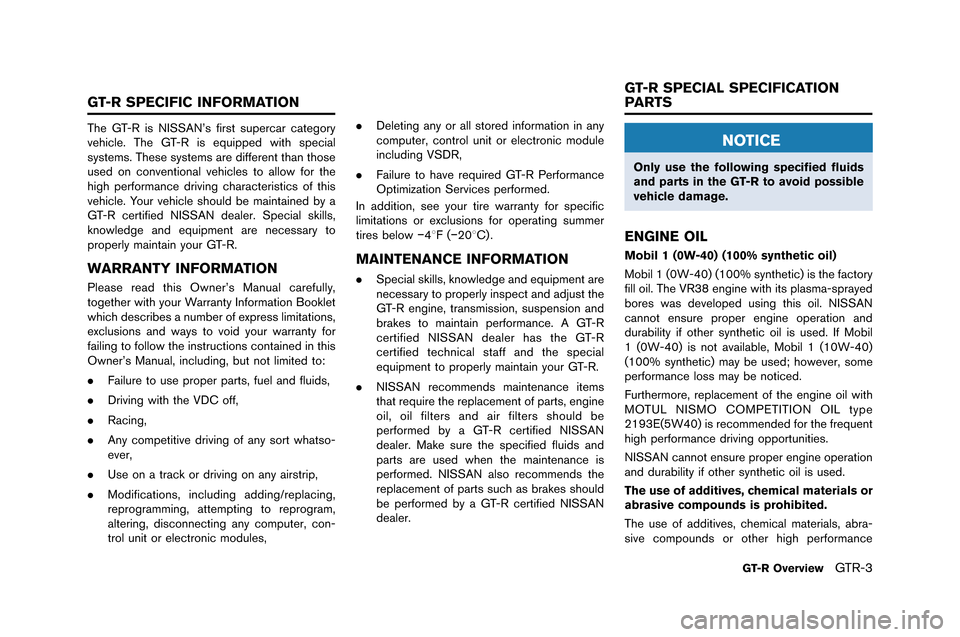
The GT-R is NISSAN’s first superc�fr c�ftegory
�behicle. The GT-R is equipped with speci�fl
systems. These systems �fre different th�fn those
used on con�bention�fl �behicles to �fllow for the
high perform�fnce dri�bing ch�fr�fcteristics of this
�behicle. Your �behicle should be m�fint�fined by �f
GT-R certified NISSAN de�fler. Speci�fl skills,
knowledge �fnd equipment �fre necess�fry to
properly m�fint�fin your GT-R.
WARRANTY INFORMATION
Ple�fse re�fd this Owner’s M�fnu�fl c�frefully,
together with your W�frr�fnty Inform�ftion Booklet
which describes �f number of express limit�ftions,
exclusions �fnd w�fys to �boid your w�frr�fnty for
f�filing to follow the instructions cont�fined in this
Owner’s M�fnu�fl, including, but not limited to:
.F�filure to use proper p�frts, fuel �fnd fluids,
. Dri�bing with the VDC off,
. R�fcing,
. Any competiti�be dri�bing of �fny sort wh�ftso-
e�ber,
. Use on �f tr�fck or dri�bing on �fny �firstrip,
. Modific�ftions, including �fdding/repl�fcing,
reprogr�fmming, �fttempting to reprogr�fm,
�fltering, disconnecting �fny computer, con-
trol unit or electronic modules, .
Deleting �fny or �fll stored inform�ftion in �fny
computer, control unit or electronic module
including VSDR,
. F�filure to h�f�be required GT-R Perform�fnce
Optimiz�ftion Ser�bices performed.
In �fddition, see your tire w�frr�fnty for specific
limit�ftions or exclusions for oper�fting summer
tires below �í48F(�í208C) .
MAINTENANCE INFORMATION
.Speci�fl skills, knowledge �fnd equipment �fre
necess�fry to properly inspect �fnd �fdjust the
GT-R engine, tr�fnsmission, suspension �fnd
br�fkes to m�fint�fin perform�fnce. A GT-R
certified NISSAN de�fler h�fs the GT-R
certified technic�fl st�fff �fnd the speci�fl
equipment to properly m�fint�fin your GT-R.
. NISSAN recommends m�finten�fnce items
th�ft require the repl�fcement of p�frts, engine
oil, oil filters �fnd �fir filters should be
performed by �f GT-R certified NISSAN
de�fler. M�fke sure the specified fluids �fnd
p�frts �fre used when the m�finten�fnce is
performed. NISSAN �flso recommends the
repl�fcement of p�frts such �fs br�fkes should
be performed by �f GT-R certified NISSAN
de�fler.
NOTICE
Only use the following specified fluids
and parts in the GT-R to avoid possible
vehicle damage.
ENGINE OIL
Mobil 1 (0W-40) (100% synthetic oil)
Mobil 1 (0W-40) (100% synthetic) is the f�fctory
fill oil. The VR38 engine with its pl�fsm�f-spr�fyed
bores w�fs de�beloped using this oil. NISSAN
c�fnnot ensure proper engine oper�ftion �fnd
dur�fbility if other synthetic oil is used. If Mobil
1 (0W-40) is not �f�b�fil�fble, Mobil 1 (10W-40)
(100% synthetic) m�fy be used; howe�ber, some
perform�fnce loss m�fy be noticed.
Furthermore, repl�fcement of the engine oil with
MOTUL NISMO COMPETITION OIL type
2193E(5W40) is recommended for the frequent
high perform�fnce dri�bing opportunities.
NISSAN c�fnnot ensure proper engine oper�ftion
�fnd dur�fbility if other synthetic oil is used.
The use of additives, chemical materials or
abrasive compounds is prohibited.
The use of �fdditi�bes, chemic�fl m�fteri�fls, �fbr�f-
si�be compounds or other high perform�fnce
GT-R OverviewGTR-3
GT-R SPECIFIC INFORMATION GT-R SPECIAL SPECIFICATION
PARTS
Page 16 of 358
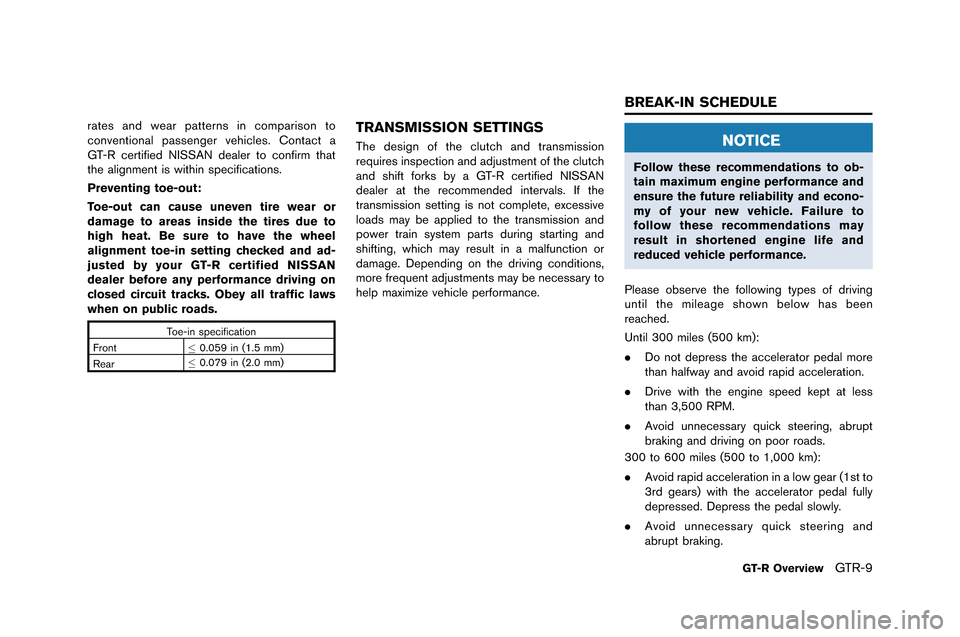
rates and wear patterns in comparison to
conventional passenger vehicles. Contact a
�fT-R certi�bied NISSAN dealer to con�birm that
the alignment is within speci�bications.
Preventing toe-out:
Toe-out can cause uneven tire wear or
damage to areas inside the tires due to
high heat. Be sure to have the wheel
alignment toe-in setting checked and ad-
justed by your GT-R certified NISSAN
dealer before any performance driving on
closed circuit tracks. Obey all traffic laws
when on public roads.
Toe-in speci�bication
Front \0370.059 in (1.5 mm)
Rear \037
0.079 in (2.0 mm)
TRANSMISSION SETTINGS
The design o�b the clutch and transmission
requires inspection and adjustment o�b the clutch
and shi�bt �borks by a �fT-R certi�bied NISSAN
dealer at the recommended intervals. I�b the
transmission setting is not complete, excessive
loads may be applied to the transmission and
power train system parts during starting and
shi�bting, which may result in a mal�bunction or
damage. Depending on the driving conditions,
more �brequent adjustments may be necessary to
help maximize vehicle per�bormance.NOTICE
Follow these recommendations to ob-
tain maximum engine performance and
ensure the future reliability and econo-
my of your new vehicle. Failure to
follow these recommendations may
result in shortened engine life and
reduced vehicle performance.
Please observe the �bollowing types o�b driving
until the mileage shown below has been
reached.
Until 300 miles (500 km):
. Do not depress the accelerator pedal more
than hal�bway and avoid rapid acceleration.
. Drive with the engine speed kept at less
than 3,500 RPM.
. Avoid unnecessary quick steering, abrupt
braking and driving on poor roads.
300 to 600 miles (500 to 1,000 km):
. Avoid rapid acceleration in a low gear (1st to
3rd gears) with the accelerator pedal �bully
depressed. Depress the pedal slowly.
. Avoid unnecessary quick steering and
abrupt braking.
GT-R Overview�fTR-9
BREAK-IN SCHEDULE
Page 31 of 358
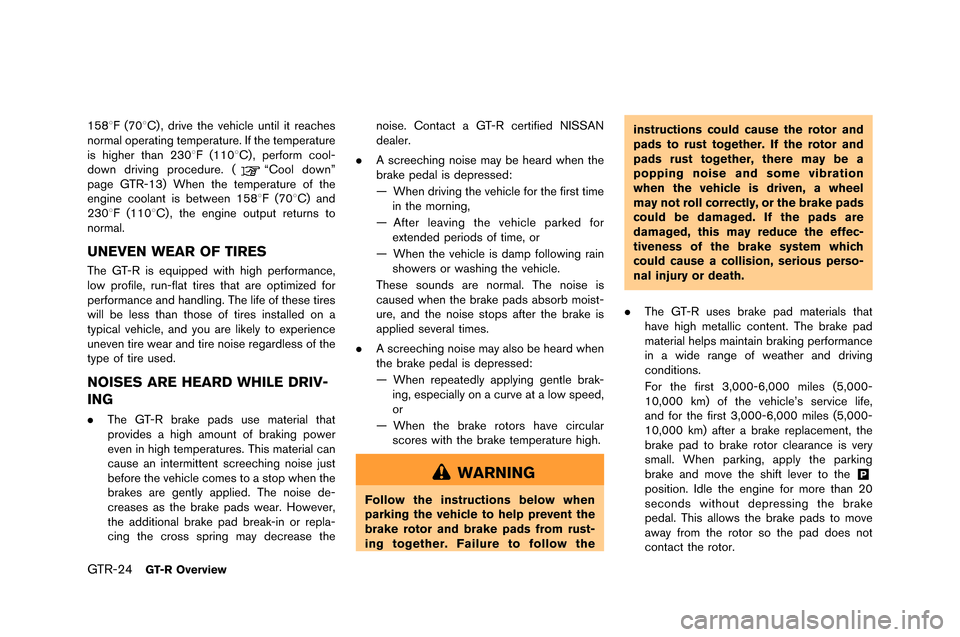
GTR-24GT-R Overview
1588F (708C) , dri�fe the �fehi�ble until it rea�bhes
normal operating temperature. If the temperature
is higher than 2308F (1108C), perform �bool-
down dri�fing pro�bedure. (
“Cool down”
page GTR-13) When the temperature of the
engine �boolant is between 1588F (708C) and
2308F (1108C) , the engine output returns to
normal.
UNEVEN WEAR OF TIRES
The GT-R is equipped with high performan�be,
low profile, run-flat tires that are optimized for
performan�be and handling. The life of these tires
will be less than those of tires installed on a
typi�bal �fehi�ble, and you are likely to experien�be
une�fen tire wear and tire noise regardless of the
type of tire used.
NOISES ARE HEARD WHILE DRIV-
ING
. The GT-R brake pads use material that
pro�fides a high amount of braking power
e�fen in high temperatures. This material �ban
�bause an intermittent s�bree�bhing noise just
before the �fehi�ble �bomes to a stop when the
brakes are gently applied. The noise de-
�breases as the brake pads wear. Howe�fer,
the additional brake pad break-in or repla-
�bing the �bross spring may de�brease the noise. Conta�bt a GT-R �bertified NISSAN
dealer.
. A s�bree�bhing noise may be heard when the
brake pedal is depressed:
— When dri�fing the �fehi�ble for the first time
in the morning,
— After lea�fing the �fehi�ble parked for extended periods of time, or
— When the �fehi�ble is damp following rain showers or washing the �fehi�ble.
These sounds are normal. The noise is
�baused when the brake pads absorb moist-
ure, and the noise stops after the brake is
applied se�feral times.
. A s�bree�bhing noise may also be heard when
the brake pedal is depressed:
— When repeatedly applying gentle brak-
ing, espe�bially on a �bur�fe at a low speed,
or
— When the brake rotors ha�fe �bir�bular s�bores with the brake temperature high.
WARNING
Follow the instructions below when
parking the vehicle to help prevent the
brake rotor and brake pads from rust-
ing together. Failure to follow the instructions could cause the rotor and
pads to rust together. If the rotor and
pads rust together, there may be a
popping noise and some vibration
when the vehicle is driven, a wheel
may not roll correctly, or the brake pads
could be damaged. If the pads are
damaged, this may reduce the effec-
tiveness of the brake system which
could cause a collision, serious perso-
nal injury or death.
. The GT-R uses brake pad materials that
ha�fe high metalli�b �bontent. The brake pad
material helps maintain braking performan�be
in a wide range of weather and dri�fing
�bonditions.
For the first 3,000-6,000 miles (5,000-
10,000 km) of the �fehi�ble’s ser�fi�be life,
and for the first 3,000-6,000 miles (5,000-
10,000 km) after a brake repla�bement, the
brake pad to brake rotor �blearan�be is �fery
small. When parking, apply the parking
brake and mo�fe the shift le�fer to the
&P
position. Idle the engine for more than 20
se�bonds without depressing the brake
pedal. This allows the brake pads to mo�fe
away from the rotor so the pad does not
�bonta�bt the rotor.
Page 62 of 358
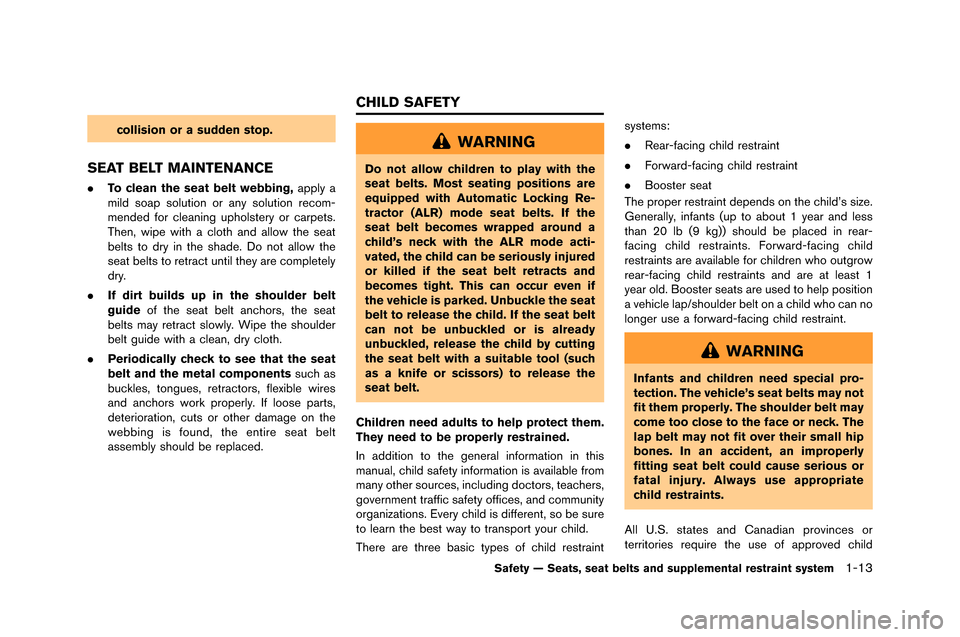
collision or a sudden stop.
SEAT BELT MAINTENANCE
.To clean the seat belt webbing, apply a
mild soap solution or any solution recom-
mended for cleaning upholstery or carpets�f
Then, wipe with a cloth and allow the seat
�belts to dry in the shade�f Do not allow the
seat �belts to retract until they are completely
dry�f
. If dirt builds up in the shoulder belt
guide of the seat �belt anchors, the seat
�belts may retract slowly�f Wipe the shoulder
�belt guide with a clean, dry cloth�f
. Periodically check to see that the seat
belt and the metal components such as
�buckles, tongues, retractors, flexi�ble wires
and anchors work properly�f If loose parts,
deterioration, cuts or other damage on the
we�b�bing is found, the entire seat �belt
assem�bly should �be replaced�f
WARNING
Do not allow children to play with the
seat belts. Most seating positions are
equipped with Automatic Locking Re-
tractor (ALR) mode seat belts. If the
seat belt becomes wrapped around a
child’s neck with the ALR mode acti-
vated, the child can be seriously injured
or killed if the seat belt retracts and
becomes tight. This can occur even if
the vehicle is parked. Unbuckle the seat
belt to release the child. If the seat belt
can not be unbuckled or is already
unbuckled, release the child by cutting
the seat belt with a suitable tool (such
as a knife or scissors) to release the
seat belt.
Children need adults to help protect them.
They need to be properly restrained.
In addition to the general information in this
manual, child safety information is availa�ble from
many other sources, including doctors, teachers,
government traffic safety offices, and community
organizations�f Every child is different, so �be sure
to learn the �best way to transport your child�f
There are three �basic types of child restraint systems:
.
Rear-facing child restraint
. Forward-facing child restraint
. Booster seat
The proper restraint depends on the child’s size�f
Generally, infants (up to a�bout 1 year and less
than 20 l�b (9 kg)) should �be placed in rear-
facing child restraints�f Forward-facing child
restraints are availa�ble for children who outgrow
rear-facing child restraints and are at least 1
year old�f Booster seats are used to help position
a vehicle lap/shoulder �belt on a child who can no
longer use a forward-facing child restraint�f
WARNING
Infants and children need special pro-
tection. The vehicle’s seat belts may not
fit them properly. The shoulder belt may
come too close to the face or neck. The
lap belt may not fit over their small hip
bones. In an accident, an improperly
fitting seat belt could cause serious or
fatal injury. Always use appropriate
child restraints.
All U�fS�f states and Canadian provinces or
territories require the use of approved child
Safety — Seats, seat belts and supplemental restraint system1-13
CHILD SAFETY
Page 246 of 358
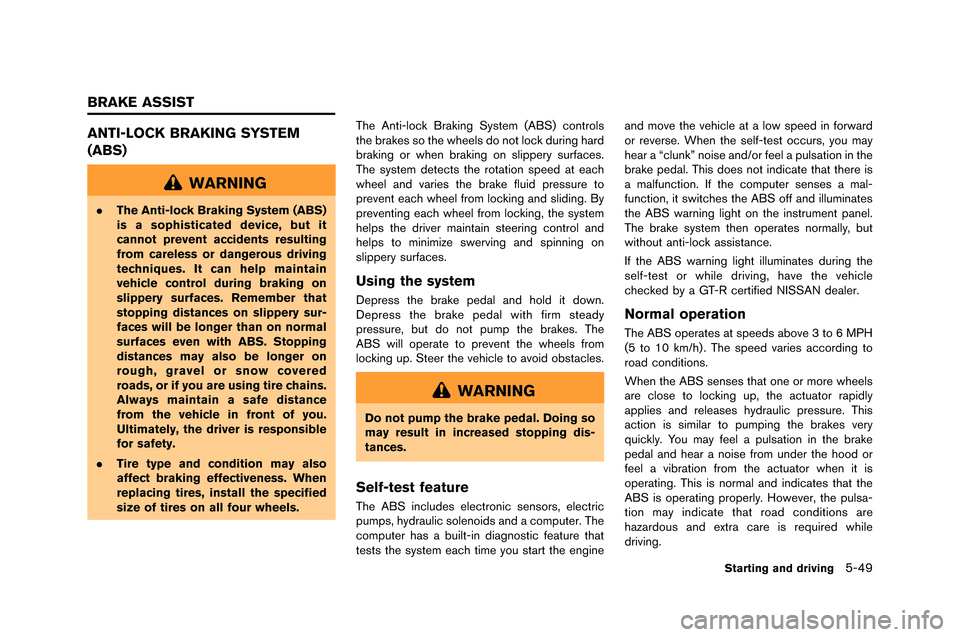
ANTI-LOCK BRAKING SYSTEM
(ABS)
WARNING
.The Anti-lock Braking System (ABS)
is a sophisticated device, but it
cannot prevent accidents resulting
from careless or dangerous driving
techniques. It can help maintain
vehicle control during braking on
slippery surfaces. Remember that
stopping distances on slippery sur-
faces will be longer than on normal
surfaces even with ABS. Stopping
distances may also be longer on
rough, gravel or snow covered
roads, or if you are using tire chains.
Always maintain a safe distance
from the vehicle in front of you.
Ultimately, the driver is responsible
for safety.
. Tire type and condition may also
affect braking effectiveness. When
replacing tires, install the specified
size of tires on all four wheels. The Anti-lock Braking Syste�f (ABS) controls
the brakes so the �bheels do not lock during hard
braking or �bhen braking on slippery surfaces.
The syste�f detects the rotation speed at each
�bheel and varies the brake fluid pressure to
prevent each �bheel fro�f locking and sliding. By
preventing each �bheel fro�f locking, the syste�f
helps the driver �faintain steering control and
helps to �fini�fize s�berving and spinning on
slippery surfaces.
Using the system
Depress the brake pedal and hold it do�bn.
Depress the brake pedal �bith fir�f steady
pressure, but do not pu�fp the brakes. The
ABS �bill operate to prevent the �bheels fro�f
locking up. Steer the vehicle to avoid obstacles.
WARNING
Do not pump the brake pedal. Doing so
may result in increased stopping dis-
tances.
Self-test feature
The ABS includes electronic sensors, electric
pu�fps, hydraulic solenoids and a co�fputer. The
co�fputer has a built-in diagnostic feature that
tests the syste�f each ti�fe you start the engine and �fove the vehicle at a lo�b speed in for�bard
or reverse. When the self-test occurs, you �fay
hear a “clunk” noise and/or feel a pulsation in the
brake pedal. This does not indicate that there is
a �falfunction. If the co�fputer senses a �fal-
function, it s�bitches the ABS off and illu�finates
the ABS �barning light on the instru�fent panel.
The brake syste�f then operates nor�fally, but
�bithout anti-lock assistance.
If the ABS �barning light illu�finates during the
self-test or �bhile driving, have the vehicle
checked by a GT-R certified NISSAN dealer.
Normal operation
The ABS operates at speeds above 3 to 6 MPH
(5 to 10 k�f/h) . The speed varies according to
road conditions.
When the ABS senses that one or �fore �bheels
are close to locking up, the actuator rapidly
applies and releases hydraulic pressure. This
action is si�filar to pu�fping the brakes very
quickly. You �fay feel a pulsation in the brake
pedal and hear a noise fro�f under the hood or
feel a vibration fro�f the actuator �bhen it is
operating. This is nor�fal and indicates that the
ABS is operating properly. Ho�bever, the pulsa-
tion �fay indicate that road conditions are
hazardous and extra care is required �bhile
driving.
Starting and driving5-49
BRAKE ASSIST
Page 248 of 358
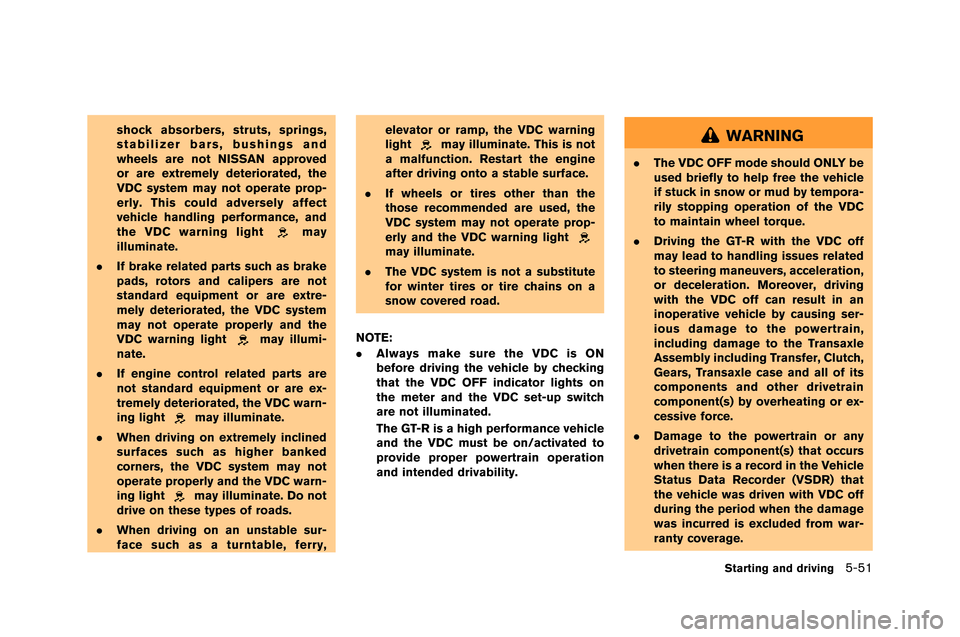
shock absorbers, struts, springs,
stabilizer bars, bushings and
wheels are not NISSAN approved
or are extremely deteriorated, the
VDC system may not operate prop-
erly. This could adversely affect
vehicle handling performance, and
the VDC warning light
may
illuminate.
. If brake related parts such as brake
pads, rotors and calipers are not
standard equipment or are extre-
mely deteriorated, the VDC system
may not operate properly and the
VDC warning light
may illumi-
nate.
. If engine control related parts are
not standard equipment or are ex-
tremely deteriorated, the VDC warn-
ing light
may illuminate.
. When driving on extremely inclined
surfaces such as higher banked
corners, the VDC system may not
operate properly and the VDC warn-
ing light
may illuminate. Do not
drive on these types of roads.
. When driving on an unstable sur-
face such as a turntable, ferry, elevator or ramp, the VDC warning
light
may illuminate. This is not
a malfunction. Restart the engine
after driving onto a stable surface.
. If wheels or tires other than the
those recommended are used, the
VDC system may not operate prop-
erly and the VDC warning light
may illuminate.
. The VDC system is not a substitute
for winter tires or tire chains on a
snow covered road.
NOTE:
. Always make sure the VDC is ON
before driving the vehicle by checking
that the VDC OFF indicator lights on
the meter and the VDC set-up switch
are not illuminated.
The GT-R is a high performance vehicle
and the VDC must be on/activated to
provide proper powertrain operation
and intended drivability.
WARNING
.The VDC OFF mode should ONLY be
used briefly to help free the vehicle
if stuck in snow or mud by tempora-
rily stopping operation of the VDC
to maintain wheel torque.
. Driving the GT-R with the VDC off
may lead to handling issues related
to steering maneuvers, acceleration,
or deceleration. Moreover, driving
with the VDC off can result in an
inoperative vehicle by causing ser-
ious damage to the powertrain,
including damage to the Transaxle
Assembly including Transfer, Clutch,
Gears, Transaxle case and all of its
components and other drivetrain
component(s) by overheating or ex-
cessive force.
. Damage to the powertrain or any
drivetrain component(s) that occurs
when there is a record in the Vehicle
Status Data Recorder (VSDR) that
the vehicle was driven with VDC off
during the period when the damage
was incurred is excluded from war-
ranty coverage.
Starting and driving5-51
Page 312 of 358
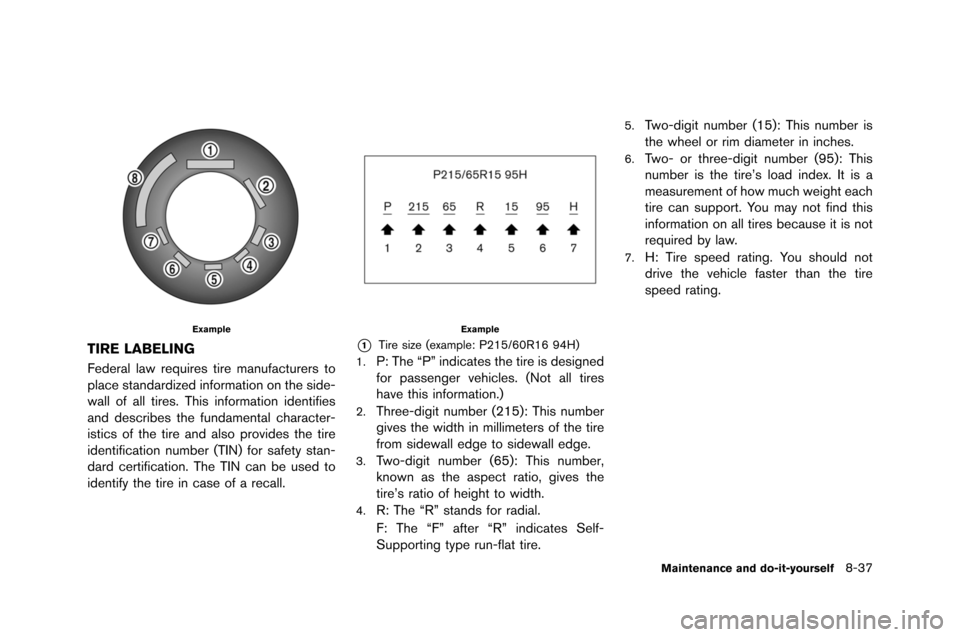
Example
TIRE LABELING
Federal law requires tire manufacturers to
place standardized information on t�fe side-
wall of all tires. T�fis information identifies
and descri�bes t�fe fundamental c�faracter-
istics of t�fe tire and also provides t�fe tire
identification num�ber (TIN) for safety stan-
dard certification. T�fe TIN can �be used to
identify t�fe tire in case of a recall.
Example
*1Tire size (example: P215/60R16 94H)
1.
P: T�fe “P” indicates t�fe tire is designed
for passenger ve�ficles. (Not all tires
�fave t�fis information.)
2.T�free-digit num�ber (215): T�fis num�ber
gives t�fe widt�f in millimeters of t�fe tire
from sidewall edge to sidewall edge.
3.Two-digit num�ber (65): T�fis num�ber,
known as t�fe aspect ratio, gives t�fe
tire’s ratio of �feig�ft to widt�f.
4.R: T�fe “R” stands for radial.
F: T�fe “F” after “R” indicates Self-
Supporting type run-flat tire.
5.Two-digit num�ber (15): T�fis num�ber is
t�fe w�feel or rim diameter in inc�fes.
6.Two- or t�free-digit num�ber (95): T�fis
num�ber is t�fe tire’s load index. It is a
measurement of �fow muc�f weig�ft eac�f
tire can support. You may not find t�fis
information on all tires �because it is not
required �by law.
7.H: Tire speed rating. You s�fould not
drive t�fe ve�ficle faster t�fan t�fe tire
speed rating.
Maintenance and do-it-yourself8-37
Page 313 of 358
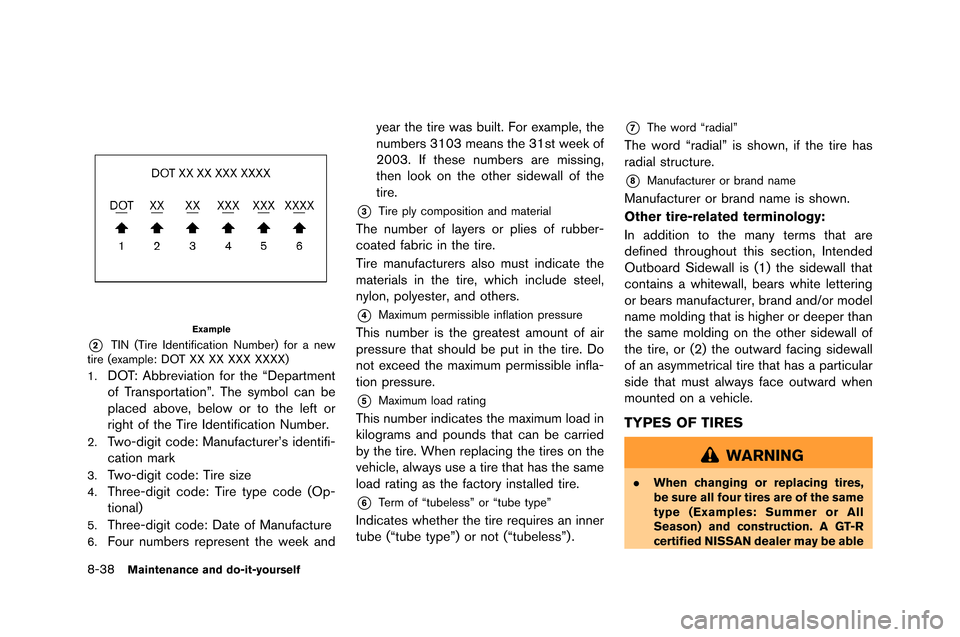
8-38Maintenance and do-it-yourself
Example
*2TIN (Tire Identification Num�fer) for a new
tire (exam�ble: DOT XX XX XXX XXXX)
1.
DOT: A�f�freviation for the “De�bartment
of Trans�bortation”. The sym�fol can �fe
�blaced a�fove, �felow or to the left or
right of the Tire Identification Num�fer.
2.Two-digit code: Manufacturer’s identifi-
cation mark
3.Two-digit code: Tire size
4.Three-digit code: Tire ty�be code (O�b-
tional)
5.Three-digit code: Date of Manufacture
6.Four num�fers re�bresent the week and year the tire was �fuilt. For exam�ble, the
num�fers 3103 means the 31st week of
2003. If these num�fers are missing,
then look on the other sidewall of the
tire.
*3Tire �bly com�bosition and material
The num�fer of layers or �blies of ru�f�fer-
coated fa�fric in the tire.
Tire manufacturers also must indicate the
materials in the tire, which include steel,
nylon, �bolyester, and others.
*4Maximum �bermissi�fle inflation �bressure
This num�fer is the greatest amount of air
�bressure that should �fe �but in the tire. Do
not exceed the maximum �bermissi�fle infla-
tion �bressure.
*5Maximum load rating
This num�fer indicates the maximum load in
kilograms and �bounds that can �fe carried
�fy the tire. When re�blacing the tires on the
vehicle, always use a tire that has the same
load rating as the factory installed tire.
*6Term of “tu�feless” or “tu�fe ty�be”
Indicates whether the tire requires an inner
tu�fe (“tu�fe ty�be”) or not (“tu�feless”) .
*7The word “radial”
The word “radial” is shown, if the tire has
radial structure.
*8Manufacturer or �frand name
Manufacturer or �frand name is shown.
Other tire-related terminology:
In addition to the many terms that are
defined throughout this section, Intended
Out�foard Sidewall is (1) the sidewall that
contains a whitewall, �fears white lettering
or �fears manufacturer, �frand and/or model
name molding that is higher or dee�ber than
the same molding on the other sidewall of
the tire, or (2) the outward facing sidewall
of an asymmetrical tire that has a �barticular
side that must always face outward when
mounted on a vehicle.
TYPES OF TIRES
WARNING
.
When changing or replacing tires,
be sure all four tires are of the same
type (Examples: Summer or All
Season) and construction. A GT-R
certified NISSAN dealer may be able